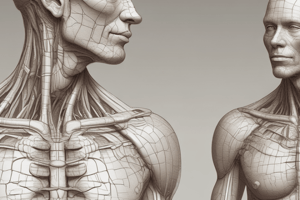Podcast
Questions and Answers
What is the outermost layer of the skin called?
What is the outermost layer of the skin called?
epidermis
What is the layer of skin located underneath the epidermis?
What is the layer of skin located underneath the epidermis?
dermis
What layer of skin is below the dermis?
What layer of skin is below the dermis?
hypodermis
What is the structure called that contains the visible part of the hair?
What is the structure called that contains the visible part of the hair?
What is the name of the structure that houses the hair root?
What is the name of the structure that houses the hair root?
What type of gland produces oil in the skin?
What type of gland produces oil in the skin?
What muscle causes hair to stand upright?
What muscle causes hair to stand upright?
What is the function of a pacinian corpuscle?
What is the function of a pacinian corpuscle?
What type of cell leads to the pacinian corpuscle?
What type of cell leads to the pacinian corpuscle?
What gland is responsible for producing sweat?
What gland is responsible for producing sweat?
What type of vessel is located closer to the hypodermis?
What type of vessel is located closer to the hypodermis?
What are the circular cells found in the hypodermis called?
What are the circular cells found in the hypodermis called?
Where is the hair root located?
Where is the hair root located?
What is the name of the sensory receptor that responds to light touch?
What is the name of the sensory receptor that responds to light touch?
Flashcards are hidden until you start studying
Study Notes
Skin Structure Overview
- Epidermis: The outermost layer of skin, consisting of stratified squamous epithelial cells; responsible for providing a barrier and protecting against environmental hazards.
- Dermis: Located beneath the epidermis, this layer contains connective tissue, blood vessels, hair follicles, and various glands; plays a key role in sensation and thermoregulation.
- Hypodermis: Also known as subcutaneous tissue; consists mainly of adipose tissue, providing insulation, energy storage, and cushioning for underlying structures.
Hair and Follicles
- Hair Shaft: The visible part of the hair that extends above the skin surface; composed of keratinized cells.
- Hair Follicle: The structure from which hair grows; anchors the hair in place and contains stem cells that support hair growth.
- Hair Root: Found within the epidermis, this part of the hair is embedded within the follicle and nourished by the dermal papilla.
Glands and Muscles
- Sebaceous Gland: Produces sebum, an oily substance that lubricates hair and skin, located alongside hair follicles.
- Arrector Pili Muscle: A small muscle associated with hair follicles that contracts to cause hair to stand upright; responsible for the phenomenon of "goosebumps".
Sensory Structures
- Pacinian Corpuscle: A type of mechanoreceptor found in the dermis that detects deep pressure and vibration.
- Nerve Fiber: Transmits sensory information, leading up to structures such as the Pacinian corpuscle.
- Meissner Corpuscle: A mechanoreceptor located in the dermis that is sensitive to light touch and texture.
Sweat and Blood Regulation
- Sweat Gland: Eccrine or apocrine glands found in the dermis that produce sweat, aiding in thermoregulation and waste excretion.
- Blood Vessel: Found within the dermis and hypodermis; crucial for thermoregulation and supplying nutrients; does not connect directly to other structures.
Specialized Tissues
- Adipose Tissue: Present in the hypodermis, consisting of circular cells; provides insulation, energy reserves, and cushioning for organs.
Studying That Suits You
Use AI to generate personalized quizzes and flashcards to suit your learning preferences.




